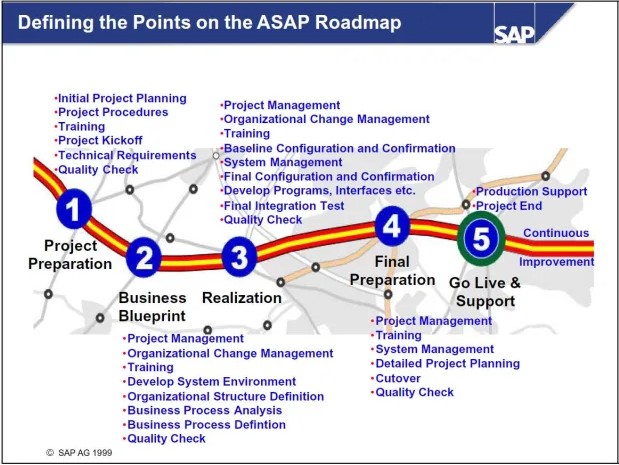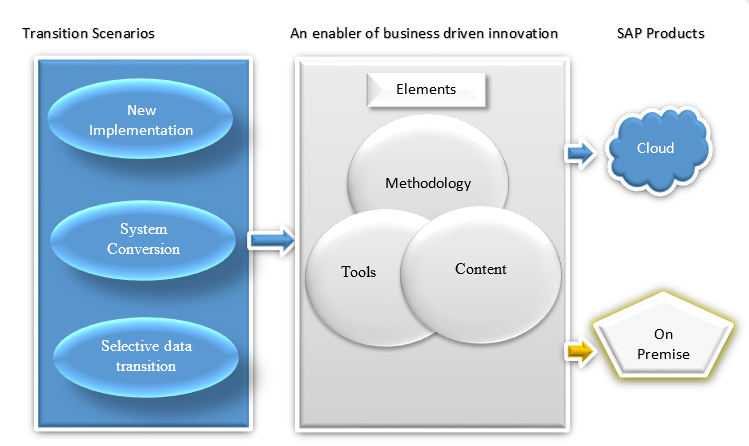SAP project management implementation methodology approaches help companies looking to implement SAP S4/HANA or any SAP solution by applying a structured project management methodology to succeed.
By following SAP’s project management implementation methodology, you get the tools, methodologies, and best practices from a company that deals with over half a million customers and has five decades of experience in every industry that ever existed.
This article aims to give the reader an idea of what it takes to implement SAP S4/HANA by first introducing the term SAP implementation, what kind of team structure do you need to succeed, and finally discussing SAP project management approaches ASAP and Activate.
Table of Contents
What is SAP Implementation?
SAP implementation is the structured methodology on how an organization or business entity adopts SAP S4/HANA or any of its solutions. An organization may either go for a comprehensive SAP ERP solution like SAP S/4HANA or a stand-alone solution like SAP Ariba, or by even going another level lower to implementing only one module within a solution, like a stand-alone SAP Ariba sourcing module.
Either way, the migration involves managing numerous activities that will put a significant burden on your departments, your budgets, and your stakeholders.
What kind of SAP team do I need?
To ensure success, you need to think about your SAP implementation like a game of chess; every move should be calculated and carefully crafted with the help of a professional team who have done this before.

What you decide on how best to set up the SAP team should be based on many factors, but the main one is around how much time your internal team can dedicate to this project, and the second critical factor is how knowledgeable is your team about ERP project and more importantly SAP.
The lower the ERP and SAP knowledge your company holds, the higher your chances of success if you rely on external help. If your company is already heavily invested in ERP and you have a solid ERP or perhaps even an SAP ECC experience, and you want to move to SAP S4/HANA, then you might think of a hybrid approach of having both dedicated internal and external teams to manage the day to day project activities.
Regardless of the team selection approach you’d want to pursue; you will absolutely need the following team members in your SAP project implementation:
- SAP Project Manager: This is the most important role to consider for your SAP project. Please do not decide to be the project manager if you are not 100% dedicated to this project and if you have not already implemented an ERP project before.
- SAP Solution Architect: This is another significant position to consider as you implement a new SAP S4/HANA system. SAP solution architects help align your business processes to the SAP system. SAP SA’s are knowledgable in integration-related topics and will drastically help if your company already works in silos. A solid Solution Architect will save you money and time along the road. The solution architect is usually a new hire.
- Business Experts: These are your company’s business process gurus. They understand your business inside and out, but they do not necessarily understand SAP. They will provide the functional consultants with the business process.
- Functional consultants: They will bridge the knowledge offered by the business experts and customize the system accordingly. They usually come with SAP knowledge relative to the domain that they are skilled in. An example of SAP functional consultants are MM, SD, PP, Ariba, FICO, ABAP, and PM consultants. These consultants are usually external hires.
- Business Analysts: They provide the business with both system and business knowledge, and they also play a vital role in moving project management activities forward. This includes unit acceptance testing (UAT), functional documentation review, working on change management activities related to training, and writing change requests. This can be an in-house or an external hire.
- Trainers: They provide end-user training.
- Master data: They are in charge of migrating your data from your old system, cleansing it, and uploading it in the system before your project’s go-live. They are critical to your company’s success.
- Change Management: Never underestimate this role. They are critical to ensure system adoption. Change managers are in charge of bringing the end-user closer to the SAP S4/HANA implementation. This includes creating communications, promoting workshops and training, bridging knowledge gaps, and finally measuring impacts and assessing the system’s usability.
Types of SAP S/4HANA Implementations
Depending on the scale of migration, there are two major categories of SAP S/4HANA implementation scenarios, which are:
SAP Greenfield: Also known as a new implementation, the Greenfield approach enables an organization to completely redesign its processes and replace all the existing methods with SAP solutions.
SAP Brownfield: In contrast, the Brownfield approach, which is also known as the system conversion approach, allows SAP implementation without completely redesigning and disrupting the existing processes. It is a more gradual and step-by-step approach toward a comprehensive SAP implementation.
There is another type of SAP implementation technique known as selective data transition. Here, a company chooses to migrate only a few business functionalities such as SAP Procurement and Sourcing, SAP Ariba, or only SAP Finance and Controlling.
SAP implementation partners assist in the process, and the selective transfer may include the ABAP repository, configuration data, transaction data, and master data.
Now let’s move on to the core topic of our discussion here – how to implement SAP S/4HANA.
How is SAP Implemented?
Traditionally SAP implementation had been done through ASAP procedure, which was developed and recommended by SAP based on the standard project management methodology. GlobalASAP methodology, a successor of ASAP, was also launched as a preconfigured system to facilitate SAP implementation for large global organizations.
Implementing SAP with ASAP and GlobalASAP Methodologies
The Accelerated SAP or ASAP method divides the complete SAP implementation and documentation tasks into five well-defined steps. All the steps include a quality overview to ensure completeness and accuracy of activities performed. The steps are:
- Project Preparation
- Business Blueprint
- Realization
- Final Preparation
- Rolling out, support, and maintenance.
The GlobalASAP approach was developed to facilitate multisite SAP implementation for large-scale companies. The key idea was to identify all activities that are not location-specific and map them with a special structure known as Global SAP Roadmap.
While you can use only one implementation strategy with ASAP, GlobalASAP is compatible with multiple R/3 implementation strategies. The preconfigured global template goes through ongoing maintenance and upgrades as it is used for the gradual rolling-out of global sites.

SAP has developed three toolsets,
- SAP Solution Composer;
- SAP Roadmaps;
- SAP Solution Manager.
However, ASAP and GlobalASAP are more suitable for on-premise implementations. To make it more appropriate for cloud-based implementations, a more advanced methodology known as SAP Activate has emerged in recent years, having several advantages over ASAP.
SAP Activate: Cloud Implementation Models
SAP Activate reflects well with the Agile PMP approach to managing projects. Instead of the very structured methods of ASAP, the SAP Activate emphasizes more on the Agile principles. The Agile method encourages continuous adjustments, fine-tuning, and improvements through sprints or short meetings along the way for project development and implementation.
In the previous ASAP model, the project team used to invest a lot of time and resources to meticulously develop the blueprint prior to the realization phase. Once the blueprint was approved, it was difficult to make any adjustments in the final project. However, the Agile-based SAP Activate solved the issue by going into the realization phase faster. In a cloud-based environment, the project team uses sprints to demonstrate how the final product would look like and can also use feedback from stakeholders for further improvements.

Now let’s learn how to structure the SAP implementation with the SAP Activate method.
Implementing SAP with SAP Activate
You can apply the SAP Activate method to all three SAP implementation scenarios. The components, methodology, and best practices of SAP Activate include:
- Agile methodology,
- Ready to run scenarios,
- Migration and integration contents,
- Guided configuration.
SAP Activate Phases
In total, there are over 15 solution-specific SAP Activate methodologies depending on what type of implementation you are looking for – greenfield, brownfield, or selective. Examples include SAP Activate for SAP S/4HANA Cloud, Transition to SAP S/4HANA, Transition to SAP BW/4HANA, SAP S/4HANA Upgrade, and Product Integration Roadmap.
Regardless of minor differences, all SAP Activate methods consist of five phases, as follows:
Prepare: Participants from both sides collaborate at this stage. They finalize project deliverables, document them properly, and kick off the project team.
Explore: The project team finalizes the business process through a series of fit-to-standard analysis sessions. SAP Consultants can also use the ready templates for additional customizations. Change managers with the help of fucntional consultants also provide strategic consulting by conducting change impact analysis.
Realize: Functional consultants, ABAPers, and SAP Solution Architects design and configure SAP S4/HANA system based on the blueprints and the new RICEFs while end-users test it through multiple levels starting with unit testing and finishing with user acceptance testing. Here, the project team mainly focuses on solving issues related to the customer’s business process.
Deploy: This is where the as-is that we defined earlier in the stages becomes the to-be process. Here, we setup the production system, continue to exectute the project management tasks, monitor risk management, issues. Once the activties have been completed and validate, risks resolved or mitigated, we turn on SAP to be used in the production enviroment.
Run: Customers need to stay updated regularly with the latest software upgrades and business practices. This phase encourages continuous improvement, continous learning, monitor usage, and document areas where the system can become better.

SAP Implementation Partners
As the implementation process is daunting for a large enterprise, they often seek help from professional SAP implementers known as SAP implementation partners. To choose your ideal SAP implementation partner, make sure you analyze their expertise, cost, and culture from your organization’s perspective. Also, choose consultants with industry and business experiences instead of solely focusing on SAP experience.
Concluding Note
SAP’s Activate or even ASAP methodology is not to be confused as a true creation of a new set of project management approaches, they really complement normal project management approaches, but they are enriched with more than fifty years of accumulated knowledge on how to best implement SAP system. Activate relies on an agile approach, and ASAP relies on a waterfall approach, and the choice is yours.
If you are looking to further enrich your knowledge in project management and SAP, it would be extra beneficial if you follow the SAP Activate for Cloud Solutions – Project Management Learning journey, offered by SAP.
- Overview of the Material Master in SAP S/4HANA - January 2, 2024
- SAP FICO TRANSACTION CODES (MOST COMMON) - December 24, 2023
- Best SAP S/4HANA MM Books for Beginners and Advanced Learners - November 25, 2023





0 Comments